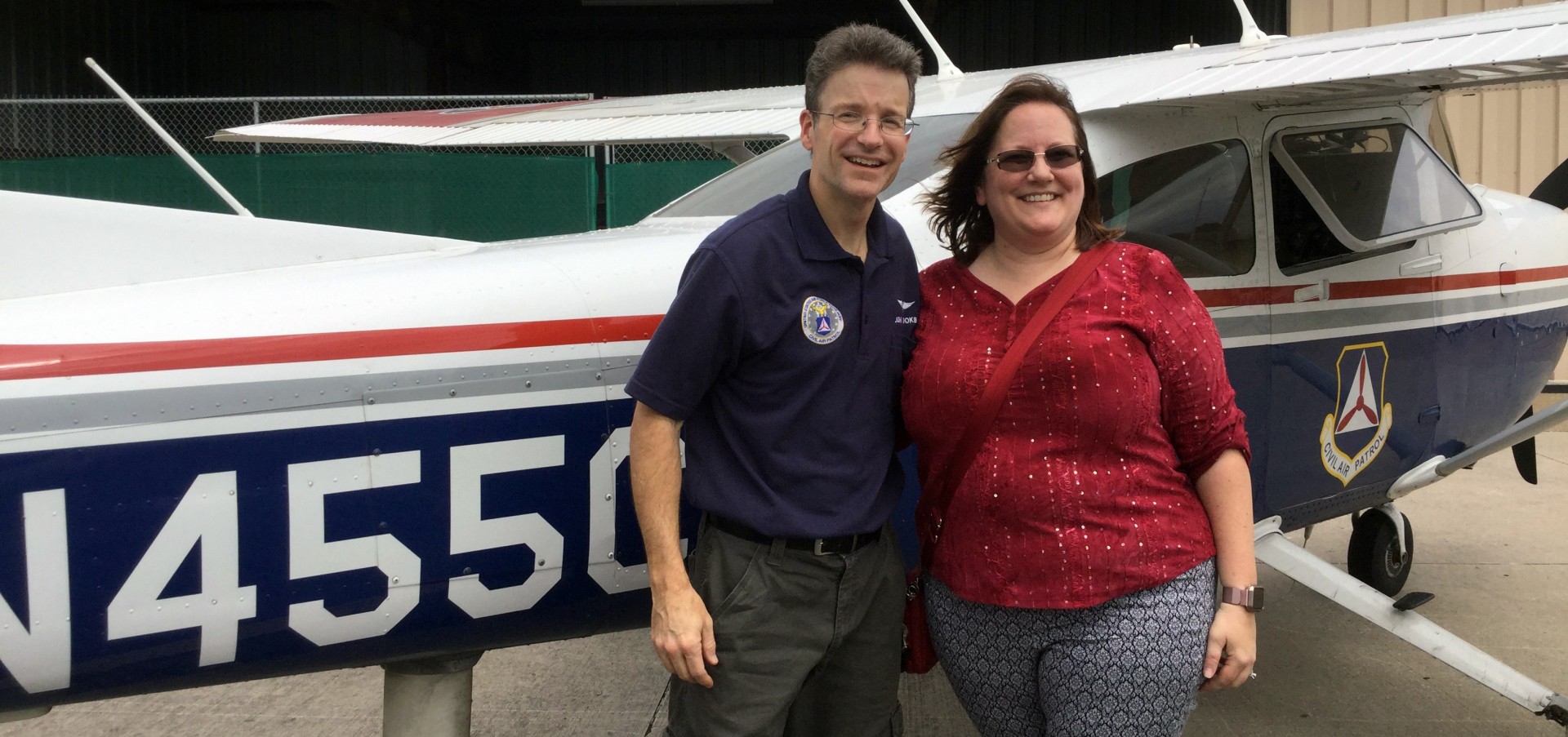Educator Orientation Flight Fires Texas Teacher's Classroom Plans
Capt. Phil Gerke
Aerospace Education Officer
Crusader Composite Squadron
Texas Wing
 Grand Prairie, Texas, educator Deanna Chapman's plans for her classroom continued to climb even after the end of her recent Teacher Orientation Program Flight (TOP Flight) ride with 2nd Lt. John Brookby of the Texas Wing’s Crusader Composite Squadron
Grand Prairie, Texas, educator Deanna Chapman's plans for her classroom continued to climb even after the end of her recent Teacher Orientation Program Flight (TOP Flight) ride with 2nd Lt. John Brookby of the Texas Wing’s Crusader Composite Squadron
Chapman is a CAP aerospace education member. She teaches sixth- an eighth-grade science at the Young Women's Leadership Academy at Arnold, a Title I public school that focuses on offering traditionally disadvantaged female students the opportunity for studies in STEM (science, technology, engineering and math) subjects.
She was so excited about the benefits of CAP’s aerospace education member program that she immediately paid the membership fee out of her own pocket instead of waiting for a purchase order to work its way through channels for funding.
Aerospace education membership provides teachers nationwide with free access to CAP's extensive aerospace education curriculum support materials, including STEM-related kits designed to guide hands-on educational activities for students from kindergarten through high school. They need not wear uniforms or attend local squadron meetings. Their mission is to instill and develop a lifelong interest in aerospace in their students.
The afternoon before the flight, a surprise thunderstorm threatened plans, but the lingering cloudiness Saturday morning provided the topic for a discussion on meteorology. In addition, the heavy cloud cover, which threatened crosswinds and rain, delayed the scheduled takeoff long enough for a thorough preflight discussion of aircraft aerodynamics.
Then, after the dark clouds moved on, the resulting stable air mass allowed for a silky smooth flight. Finally, residual high clouds filtered the normally scorching summer sun, keeping cockpit temperatures comfortable.
"I actually expected the flight to be bumpier, and the takeoff and the landing to be rougher, so I was surprised at how smooth things were,” Chapman said. “It was a little scary at first to think about going up in something that small, but once we got up there it wasn't scary at all.
"It was actually fun.”
What impressed Chapman the most was CAP pilots’ depth of knowledge about the weather and how airplanes work – factors that dovetail with teaching subjects like weather and the forces of motion.
Chapman's hour in the air was greatly enhanced by the 30 minutes she spent walking around the CAP Cessna with Brookby during the preflight discussion. As the pilot described the various aerodynamic forces that act on a plane, the teacher interpreted them as applications of science and math to aeronautics.
The two talked about how thrust and drag operate in balance in level flight, as do lift and gravity. But any change to a control surface on the wing or tail, or any change in power or loading, changes that balance.
They discussed what happens when engine power is increased or reduced, as well as the various effects of turning, climbing and descending.
"Because we discussed all these in depth on the ground," Brookby said, "we were then able to feel those forces in flight.”
Chapman appreciated the demonstration of the science of flight, and she hopes to be able to use these real-life applications of aeronautic principles in her classroom to help her students better understand physical science concepts.
"I am eager to get them thinking about going into aviation,” she said. “I teach at an all-girl school; getting our girls excited about science, engineering or any of the STEM fields is really important to our school.
Being able to show them that, yes, look, women can do this! We can learn these things, we can do these things, and look how much fun it is!"
A major difference Chapman noticed between the small Cessna and the large airliners on which she frequently flies was the CAP plane’s sensitivity to air currents.
"When we were doing the turns, I could feel the movement of the airplane with the winds," she said. "You don't experience that on an airliner, unless you get heavy turbulence."
Chapman was given the opportunity to handle the aircraft controls after the plane reached a safe altitude “That was a step outside my comfort zone, but it was a great experience,” she said,
“I didn't realize how much force there was on the yoke. When I first took over, the nose started to go down a little, so I had to learn to keep pulling back a little to keep it level. And then, just a slight turn [of the yoke] and we were banking, actually going somewhere."
She also expressed surprise at the distance the plane traveled. "I didn't realize how far we had gone until after we got back down on the ground and saw the track of the flight on the map,” she said.“We actually went all over the place, even though it felt like we really didn't go very far at all.
“It was so calm and very peaceful up there. It was fun to have that time to steer the plane."
She gained another perspective on distance as well. "When you get up in the air you can see Arlington, Grand Prairie and Dallas all at the same time,” she said. “When you are standing on the ground, you just don't realize how big the area is here. However, from the air, you get to see it all and it is really huge up there.”




